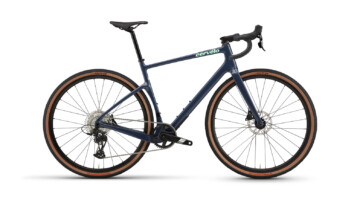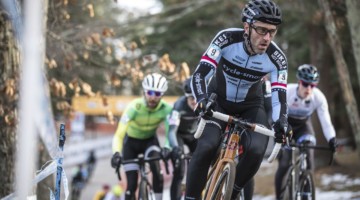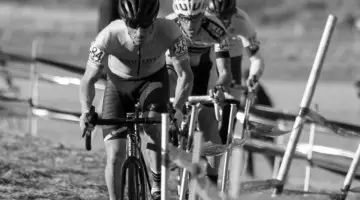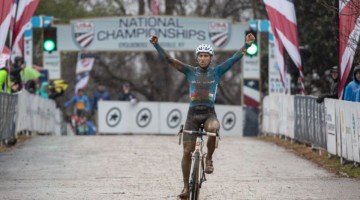When we took a closer look at cyclocross traditions, between the Elite racers we interviewed it was unanimous that warming up before your race is a wise idea—but for how long? And do you ride on the course, or set up your trainer and warm up there?
In this week’s Technique Tuesday, Adam Myerson goes in-depth on what the best way to warm up for a cyclocross race is. He outlines a detailed approach that gives the racer ample time to inspect the course at different speeds, think about equipment and clothing, warm up their body and open up physically for the race ahead.
You can find other training ideas and articles at cycle-smart.com, as well as information on internationally-recognized coaching and clinic programs for all skill levels.
by Adam Myerson
I’ve written about warming up before, and certainly the information in my previous article applies to cyclocross. However, there are additional considerations when warming up for cyclocross that are unique to ‘cross, or at the very least, more important than they are for other disciplines. Course inspection is the primary additional concern that affects all other factors.
From a physiological standpoint, the same rules apply. Any warm up should be as short as possible to achieve the desired effect. That duration and the work you do will change depending on the event, from 15 minutes of easy riding and a couple of sprints, to an hour on the trainer with a specific interval routine. So for ‘cross, where you’re warming up for a 30-60 minute race that starts with an all out sprint and continues at threshold but with a variable power output, it is crucial to be prepared for that intensity by touching all those efforts in your warm up.
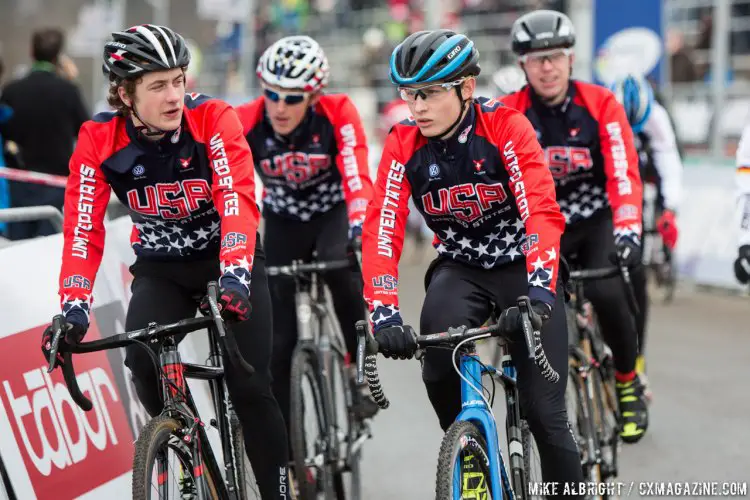
While cyclocross’ high-intensity makes a warm-up important, its technical nature makes course inspection time invaluable. © Mike Albright / Cyclocross Magazine
But ‘cross has a technical aspect that also needs to be addressed as part of the warm up: course inspection. If you’ve ever experienced that mid-race sensation where you finally feel like you have the lines dialed and are going fast, that means you didn’t prepare properly for the course beforehand. Proper course inspection means that sensation should happen on lap 1, and if it doesn’t, you’ve given something away in your performance with inadequate preparation.
Herein lies the challenge: a 15-minute warmup might be enough for many people physically, but it’s not enough to pre-ride a course and have it committed to memory. On the other side, it might take someone 45 minutes of pre-riding in two or three sessions between races to finally have a handle on the course, and that may be beyond the fitness a person has once the race starts. It can leave a rider showing up to the start line tired from their warm up and possibly even underfueled or dehydrated. So where’s the balance?
For a North American elite rider, a typical routine is to warm up in three sessions, beginning 2-3 hours before the start, between races, and depending on the race schedule.
Each session has a different goal:
- Course inspection at an endurance pace
- Hot laps at race pace, and
- A final pre-race warm up on a trainer or near the start area.
This routine requires being ready to get on the course at the finish of the race that happens two races before yours. So if your race is at 3 p.m. and there are starts every hour, you ideally want to be ready to get on the course for your first warm up around 12:30 or 12:45. There is an accepted protocol in the Northeast of waiting at the finish line for the winner to cross, which officially opens the course past the finish line for warm up, but only behind the last finisher on the course. For this to work, every rider has to be aware of and respect the last rider on the course, never passing them or even getting very close to them. (It should go without saying never to warm up on the course while a race is happening in front of a rider who is still racing.) Not every region allows this, which may limit your course inspection time to only one lap between races, which makes it crucial to make the most of it.
That first warm up session is strictly for inspection. You are not riding hard or running at all. Just 15 minutes riding a lap or two, looking, walking the runs, and taking note of particular features. If the course is open for long enough, you may even re-ride a section to get a second look at it. During this first course inspection is when you should also start to make a decision about what tires to ride, and at what pressure. After this inspection, have something to eat and drink in the 250-500 calorie range, and get your equipment ready for the next window.
The second warm up session is where you want to both begin to open yourself up physically, and test the course out at speed. This should be done just before the race that’s one race before yours. If you only have a single lap window, you may want to spend a few minutes on the trainer or the road warming up for your warm up, so to speak, so you can get on the course and begin to pedal hard right off the bat. If you’ll have more than 1 lap to work with, then the first lap can serve that purpose, and the second lap is the one you’ll want to rip. This session should also take about 15 minutes.
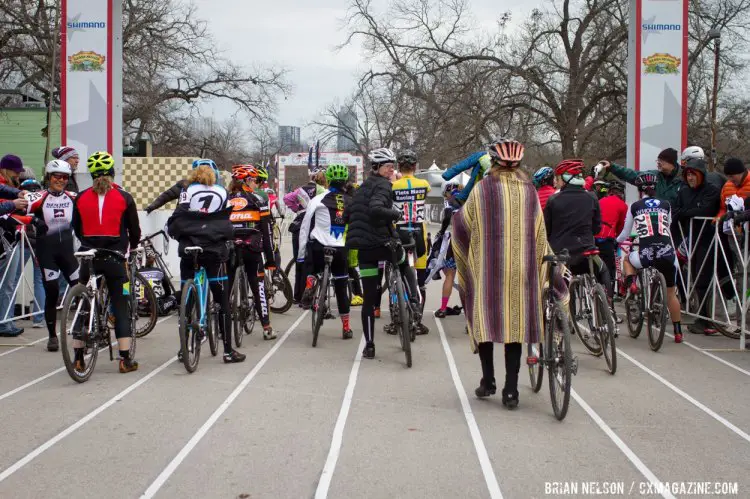
After your second warm up session, consider your clothing choices—will they be right for the race? Be sure you have a jacket, or poncho, to wear to the start line you can toss to a friend or teammate. © Brian Nelson
After this session, you’ll want to change out of the clothes you warmed up in so far, and into the clothes you plan to race in. Warming up in different clothing lets you keep your race kit dry, but also gives you time to decide what to wear, based on your warm up. (You should go to the start line with an extra layer that you can remove just before the race begins.) Again, you want to eat and drink something light, in the 100-250 calorie range, and then get ready for your final warm up.
The 3rd warm up session should also be about 15 minutes long, and start about 30 minutes before the race. The goal here is not that more warm up is required, but it’s almost a recovery ride from the previous warm up efforts, and a literal, physical warming of the body if the weather is cold, as it often is. You want to go to the start line physically warm. This is also the window where you want to prepare for the start itself, and so three short sprints of 10 seconds each with a minute or two between each one should happen near the end of the session, or on the way to the start line, depending on timing.
Of course, what I’ve laid out here is an ideal in every way: it assumes sufficient warm up time between races. It assumes you arrived at the venue 3-4 hours before your start. It assume you’re fit enough to do all that riding and not go to the start line already tired. And it assumes your race isn’t at 8 am. But what if none of those things are true? How do you adjust this ideal set up for your reality?
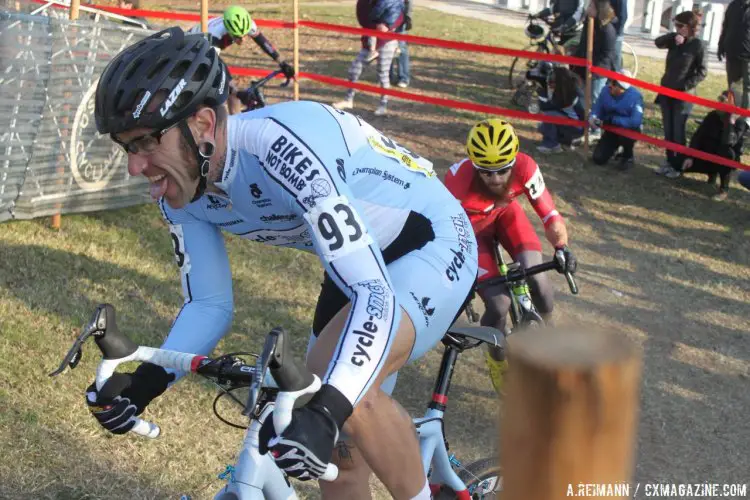
Follow Myerson’s warm-up tips, get your course inspection and line selection dialed in, and you’ll have the chance to drive your bike as well as the man himself. © Andrew Reimann/Cyclocross Magazine
If your race is the first one of the day, one advantage is that you essentially have unlimited course inspection time. And it’s reasonable to assume your fitness is at a lower level, so the shortest warmup necessary would be preferable. At the same time, if you’re a new or beginner rider, you also need the most time on the course, and you most likely will be racing in the most challenging course conditions of the day. You’ll often face melting frost, dewy turns, wet grass that turns to slippery mud that will dry out as the day goes on. This is where the trade off between course inspection time and ideal warm up pedaling time really comes into play, not to mention having to get up early, and time your eating appropriately.
For those riders in the first race of the day, you can compress this warm up into a single session. One lap to look, one lap at speed, back to your car to make any changes to things like gloves or hats, and then off to the start line. Any warming up you can do beyond that is bonus, but this approach should still get you about 30 minutes of riding total. Ideally you’d begin about an hour before the start, if possible.
Again, there is always a trade off between fitness and course inspection time. For many riders, one warm up session of course inspection between races may be all they have time, motivation, and fitness for. If there’s a major point to take away, regardless of your level, it’s that more of your warm up time should be spent on the course than on the trainer. This becomes difficult if your races are especially muddy and you’re not a pro with 3 bikes and a mechanic who’ll wash them between sessions, so again, it’s a matter of how much energy you want to put in to preparation, too. Because ‘cross is not just about fitness, but also technique, a big part of your performance is going to depend on knowing the course and being able to rail it on lap 1. Spending all your warm up time on the trainer will only get you half of that equation.
Want more tips on cyclocross technique and training? Take a look at our Cyclocross Academy archives.

